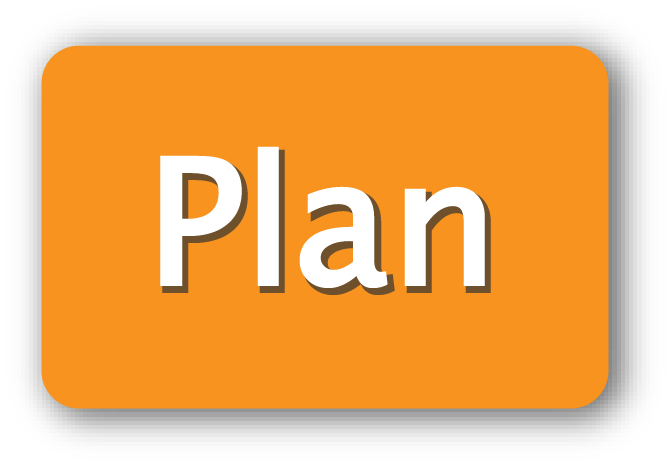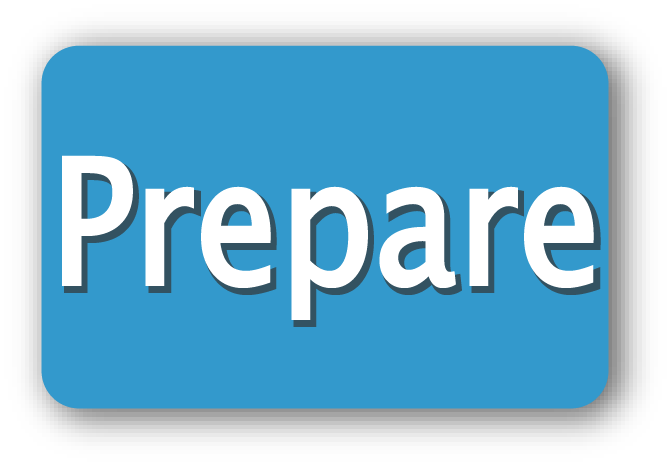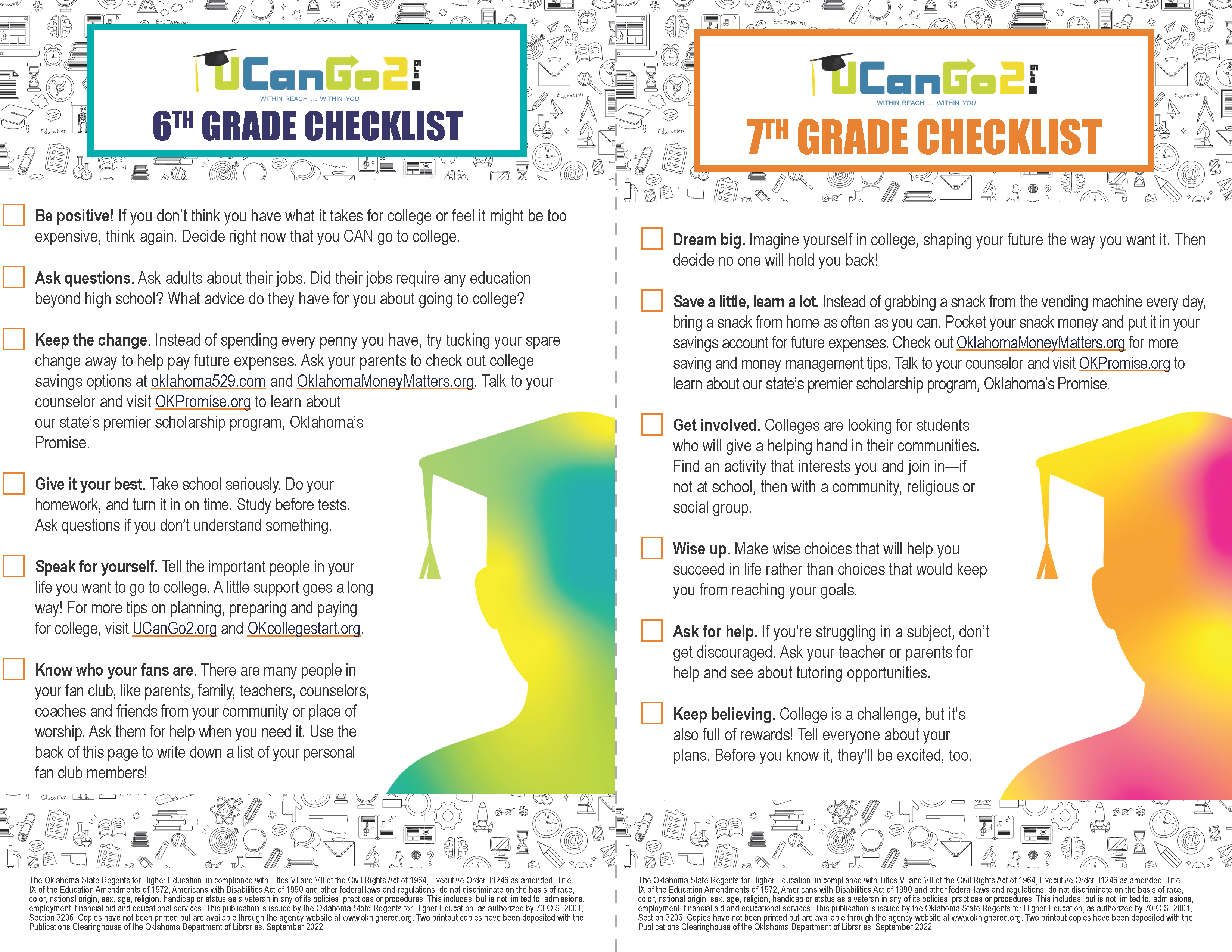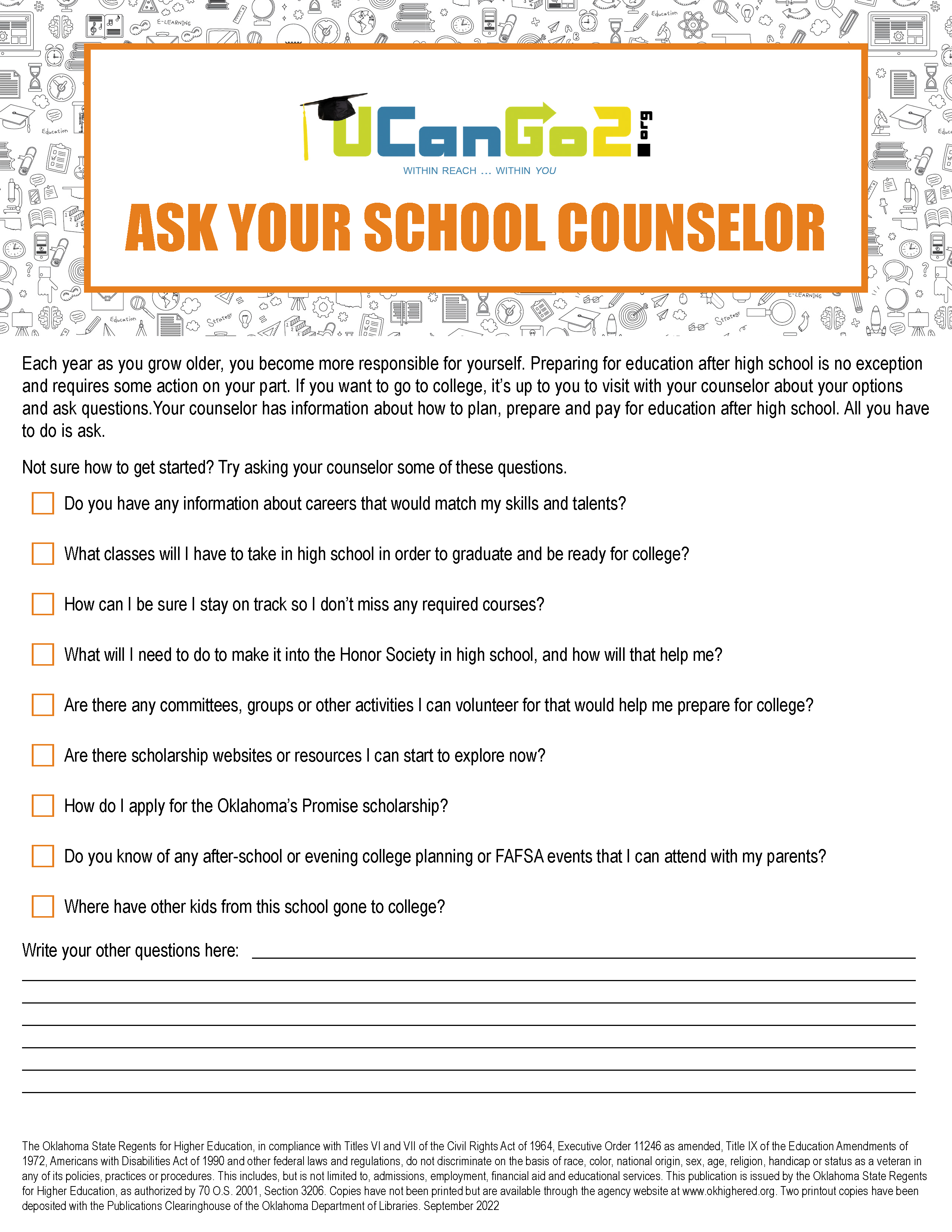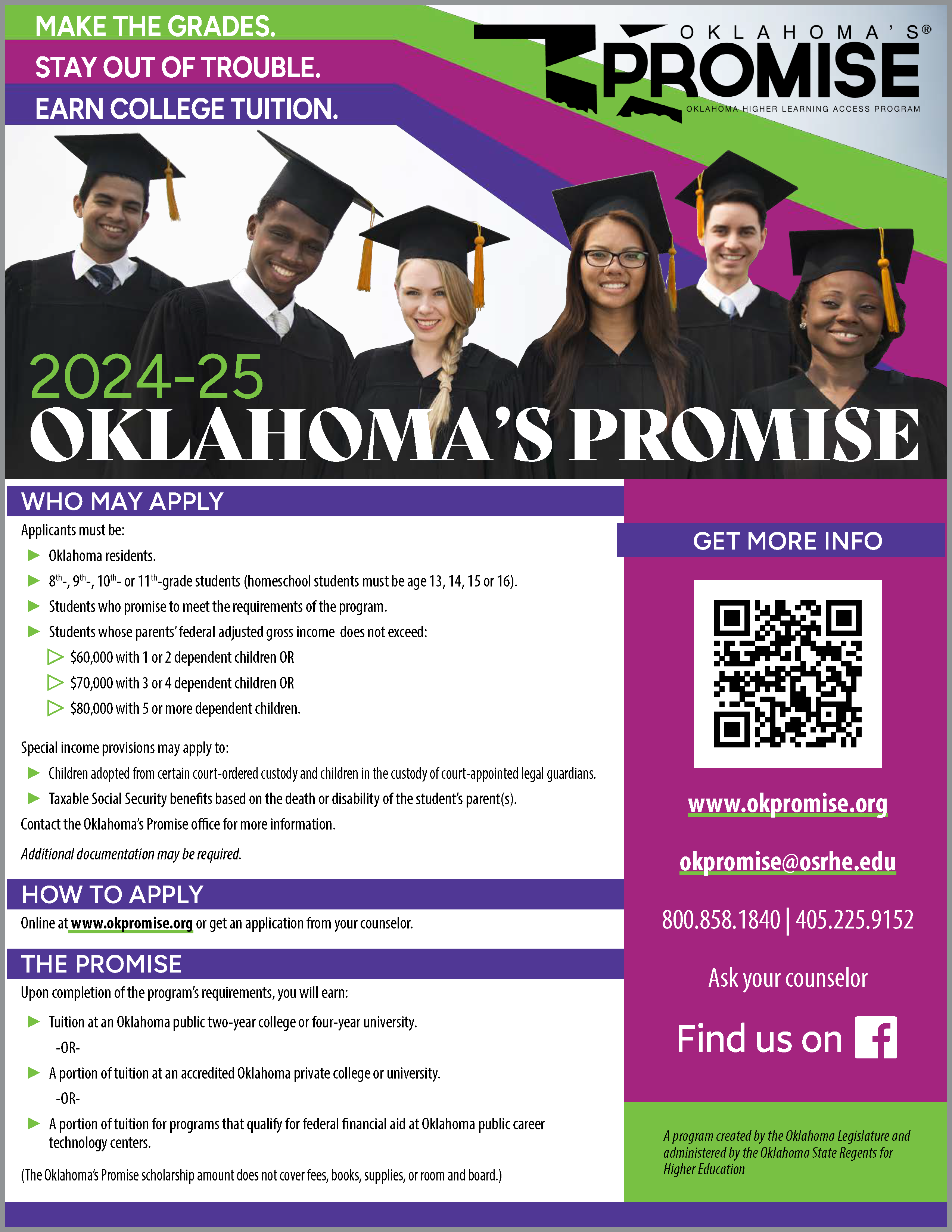Preparing for College in Middle School
Where to Start
If you’ve thought about going to college after you finish high school, you’re on the right track. Now it’s time to decide how you’ll get there. College may seem like a long way off, but each step you take in your education from now on is a step toward college. It’s important to set your goals and plan the steps you’ll take to reach them.
- SMART Goals
- Study Habits
- From Middle to High School
- From High School to College
SMART Goals
A famous Oklahoman, Will Rogers, once said, “Even if you’re on the right track, you’ll get run over if you just sit there.” If you're planning to go to college, it’s important to learn how to set your goals and plan the steps you’ll take to reach them. As you begin setting your goals, remember to “Think SMART!”
A SMART goal is a goal that’s Specific, Measurable, Attainable, Relevant and Time-based. It’s a goal that’s very clear and easily understood.
Specific
The goal must clearly state what’s to be achieved, by whom, where and when it’s to be achieved.
Example: I want to save $250 by the end of next year.
Measurable
Measurability applies to your goal at the end and to the steps taken along the way to reaching the goal. It answers the question of quantity: How much? How often? How many?
Example: I’ll need to save $3 from my allowance each week and save $94 by eating less junk food and by doing extra jobs around the house, like yard work, painting or babysitting.
Attainable
You should be sure the goals you set are achievable or you’ll get discouraged, and you may not reach them.
Example: If my allowance is $5 a week and I save $3 a week, I won’t have much money left over to spend on other things I need.
Relevant
Your goals must be related to what you want to achieve—not only right now, but further on down the road.
Example: Saving $250 or more each year will be an important step in paying for college.
Time-based
If you have a deadline, you can break your goal down into pieces that will be much easier to accomplish. If you keep reaching the smaller goals, it’ll be much easier to reach the big one at just the right time.
Example: By making monthly deposits into my savings account, I plan to save $250 by Dec. 31.
Next tab: "Study Habits"
Study Habits
Good study habits make for good grades. Good grades can help you get into college and increase your chances for winning scholarships to help pay for it. If you're having trouble keeping your grades up, the study tips below can help. Make it a goal to raise your grades, and talk to your parents and school counselor to help execute a plan for improvement.
The Perfect 10 Study Habits
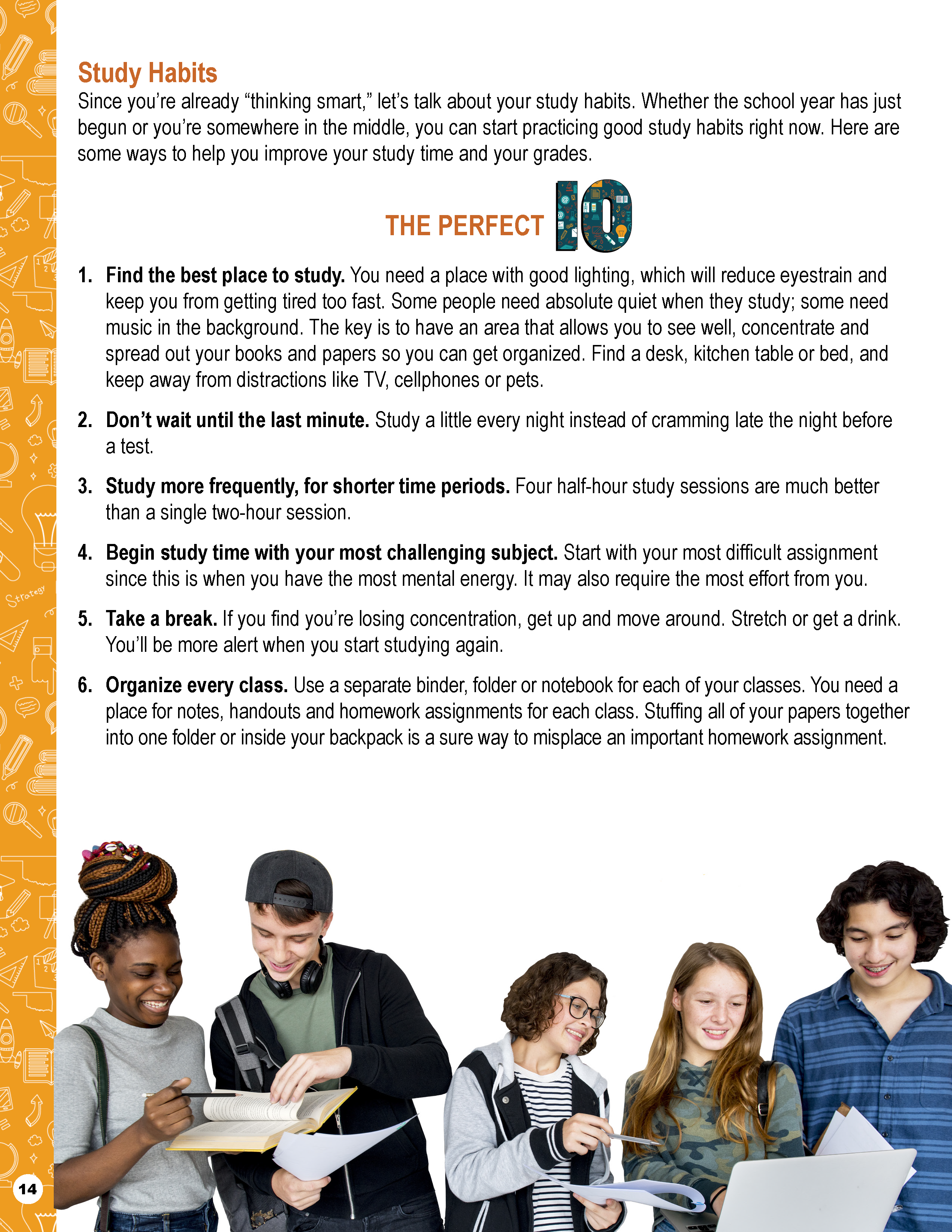 Find a good place to study that's free of distractions and has good light.
Find a good place to study that's free of distractions and has good light.- Don't wait until the last minute.
- Study frequently, in shorter time periods. Four half-hour sessions are better than a two-hour session.
- Begin study time with your most challenging subject.
- Take a break when you find yourself losing focus.
- Organize every class using separate folders or binders for each.
- Get organized each night for the next day.
- Make the most of classroom time by listening, taking notes, and using free time for classwork or to study.
- Study with friends.
- Ask for help.
Next tab: "From Middle to High School"
Previous tab: "SMART Goals"
The Road From Middle to High School
It may seem like it’s too early to think about college, but it’s not. Your journey to college can begin today. Going to college can give you more advantages in life. It can help you find a rewarding career with better pay and give you opportunities you wouldn’t have if you stopped your education after graduating from high school. It’s true your high school courses and grades are what count for getting into college, but the courses you take in middle school are the building blocks for high school. For example, if you take more challenging math classes in middle school, you’ll be learning the basics that will prepare you for more advanced math and science courses in high school, which will help you succeed on college entrance exams.
Have you considered taking a foreign language course in middle school, if it’s available? Many college programs require two years of foreign language. Taking a foreign language in middle school can give you a head start on mastering a new language.
While you’re in middle school and high school, you’ll also have chances to participate in activities outside of regular class work, such as sports, clubs, music and community service projects. Take advantage of these extracurricular activities, and keep a record of everything you do. Colleges like to see students with experience in different settings outside the classroom.
Be sure to ask your teacher or counselor about enrolling in the Oklahoma’s Promise scholarship program when you’re in the 8th, 9th, 10th or 11th grade.
Next tab: "From High School to College"
Previous tab: "Study Habits"
The Road From High School to College
You can go to college. You just have to be willing to work hard, take the right classes in high school and earn the right grades to continue your education. Your teachers and counselors will have an up-to-date list of courses required for college admission. Check in with an adviser often to make sure you’re taking the classes you need, and don’t forget to keep track of all your extracurricular activities for scholarship applications.
A college admission counselor looks at a lot of different things when deciding if you’re qualified to enroll:
- “Core” classes you took in high school (classes required for entrance into most colleges).
- Your high school grade-point average (GPA), especially for your “core” classes.
- ACT/SAT scores.
- Your high school class ranking.
- Your participation in extracurricular activities and volunteer work/community service.
To keep your GPA at an acceptable level, you’ll have to keep an eye on your college goal through every grade in high school. Don’t give in to the temptation to “slack off.” Every grade is important as you prepare to enter college.
Would you like to try out college before leaving high school? Consider signing up for concurrent enrollment classes. If you’ve made good grades throughout school or scored well on the ACT or SAT, you might be able to take college credit-earning courses in the 11th or 12th grade.
Another way to earn college credit in high school is through advanced placement (AP). Advanced Placement courses allow you to take college-level course work in high school and receive credit from Oklahoma state colleges and universities if you pass the AP subject exam.
Talk to your high school adviser to see which of these options may be available to you.
Previous tab: "From Middle to High School"
